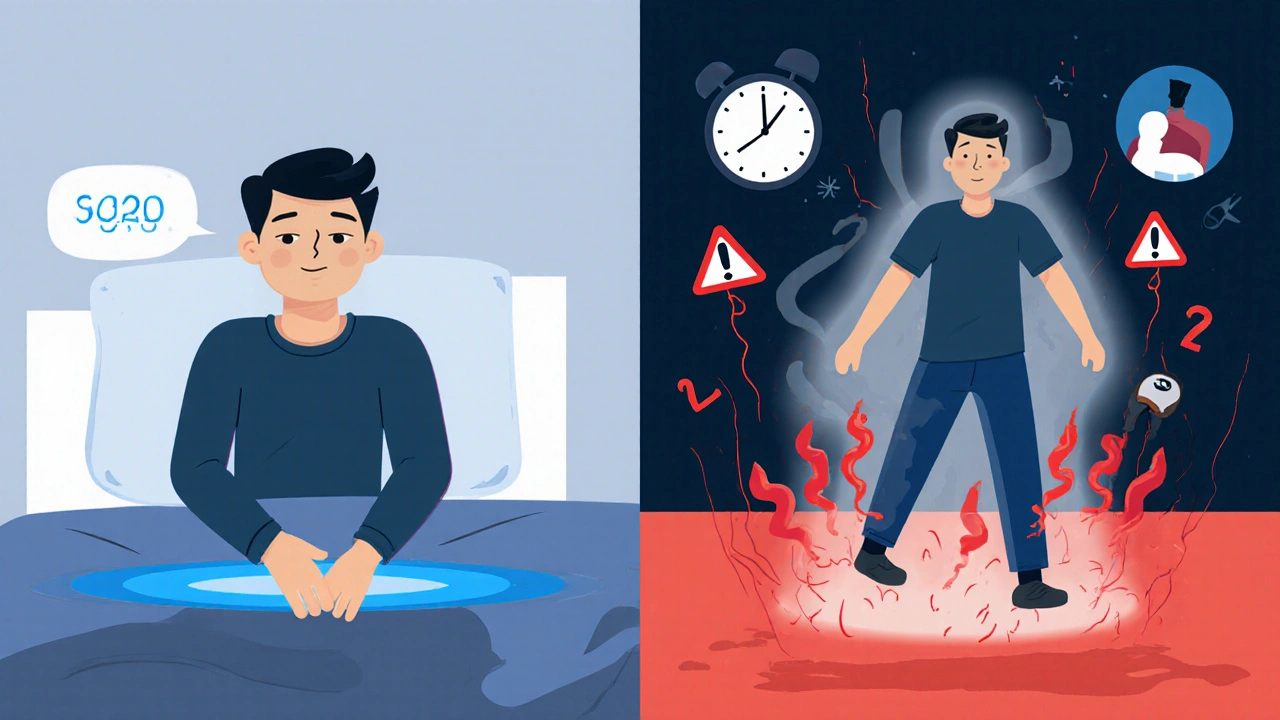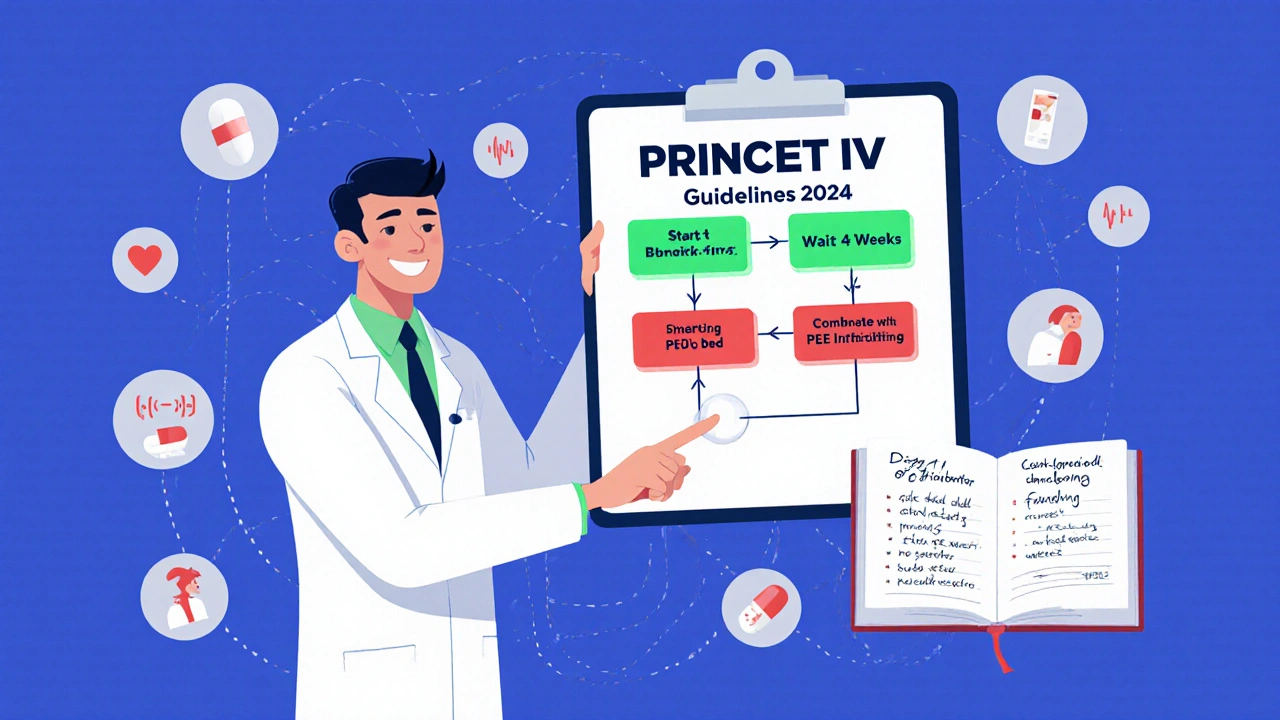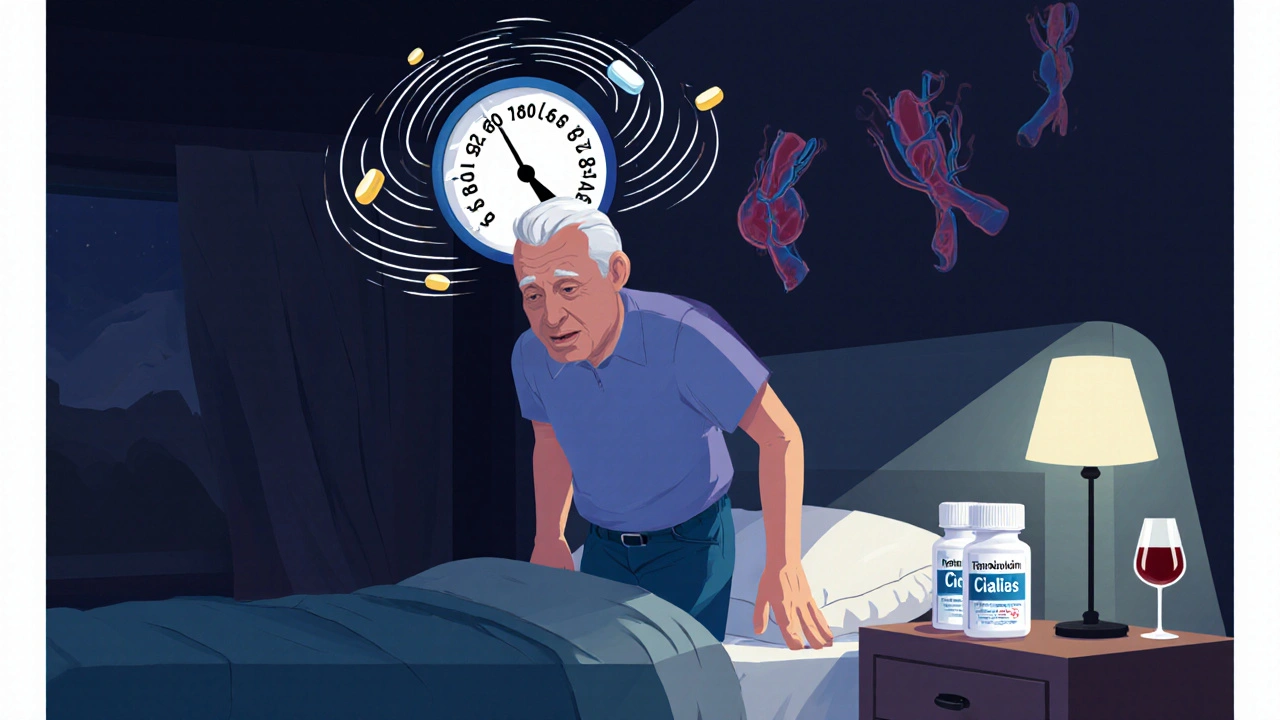Combining alpha-blockers and PDE5 inhibitors might seem like a smart way to treat two common problems at once - enlarged prostate and erectile dysfunction. But for many men, this combo comes with a dangerous side effect: sudden dizziness or even fainting. It’s not rare. It’s not theoretical. It’s happening in real time, often when people least expect it - like getting up in the middle of the night to use the bathroom.
Why This Combo Can Make You Feel Like You’re Falling
Alpha-blockers like tamsulosin (Flomax), terazosin, and doxazosin work by relaxing muscles in the prostate and blood vessels. That helps with urine flow and lowers blood pressure. PDE5 inhibitors - sildenafil (Viagra), tadalafil (Cialis), vardenafil (Levitra), and avanafil (Stendra) - boost blood flow to the penis by widening arteries. Both types of drugs lower blood pressure. When you take them together, their effects don’t just add up - they multiply.That’s why your blood pressure can drop too far, too fast. The medical term is orthostatic hypotension: a sudden dip in blood pressure when you stand up. A drop of 20 mmHg in systolic pressure (the top number) or 10 mmHg in diastolic (the bottom number) within three minutes of standing counts as orthostatic hypotension. In some cases, the drop exceeds 30 mmHg - enough to make you lightheaded, blurry-visioned, or pass out.
Studies show that about 4.7% of men taking both types of drugs report dizziness. That might sound low, but consider this: in real life, it’s often worse. One patient, JohnDoe67, posted on a medical forum that after taking tadalafil and tamsulosin, he fainted at 2 a.m. while walking to the bathroom. His blood pressure when he woke up? 82/54. That’s dangerously low. He didn’t just feel dizzy - he hit his shoulder hard on the floor.
Which Drugs Are the Most Risky?
Not all alpha-blockers are created equal. Non-selective ones like terazosin and doxazosin affect blood vessels more broadly, making them riskier when paired with PDE5 inhibitors. Tamsulosin (Flomax), on the other hand, is called “uroselective” - it targets the prostate more than the arteries. That makes it safer, but not safe.Even tamsulosin can cause fainting when combined with Cialis or Viagra. The risk isn’t about the brand name - it’s about the mechanism. Both drug classes push your blood pressure down. Add alcohol? That’s like pouring gasoline on the fire. Alcohol also dilates blood vessels. Studies show it can increase the risk of symptomatic low blood pressure by 37% when taken with PDE5 inhibitors.
Here’s what the data says about common side effects when these drugs are combined:
| Side Effect | Reported Rate in Combination Therapy |
|---|---|
| Dizziness | 4.7% - 5.2% |
| Headache | 5.36% |
| Flushing | 3.17% |
| Upset stomach | 2.98% |
| Blurred vision | 2.6% |
| Fainting | Up to 5.8% (cases requiring discontinuation) |
These numbers might look small, but for someone who faints once, it’s 100% of the time. And fainting isn’t just embarrassing - it can lead to fractures, head injuries, or hospitalization.
When Is the Risk Highest?
The danger isn’t constant. It spikes during specific times:- 1-2 hours after taking the PDE5 inhibitor: That’s when blood levels peak. If you take Cialis at 8 p.m. and stand up at 9:30 p.m., you’re in the danger zone.
- When standing up quickly: Sitting or lying down is fine. Standing - especially from bed - is risky. The body doesn’t have time to adjust blood flow.
- After drinking alcohol: Even one drink can push you over the edge.
- If you’re over 65: Blood pressure regulation slows with age. Older men are far more vulnerable.
- If you’re already on other blood pressure meds: Combining three or more drugs that lower BP is a recipe for trouble.
Reddit threads and patient forums are full of stories like this: “Felt like I was on a rocking boat for three hours after taking Cialis with Flomax.” Or: “I got dizzy every time I stood up - even walking to the kitchen.” These aren’t outliers. They’re predictable outcomes.

How Doctors Are Managing the Risk
Guidelines have changed because of these risks. The Princeton IV consensus (2024) and the American Urological Association both say: don’t start both drugs at the same time.Here’s what safe management looks like:
- Start with the alpha-blocker alone. Give it 2-4 weeks. Let your body adjust. Many men don’t even need the PDE5 inhibitor after that - their symptoms improve.
- If you add a PDE5 inhibitor, use the lowest dose. For tadalafil, that’s 5 mg, not 10 or 20. For sildenafil, start with 25 mg, not 50 or 100.
- Space the doses apart. Take your alpha-blocker in the morning and your PDE5 inhibitor at night. This reduces peak overlap. Some experts recommend waiting at least 4 hours between doses.
- Never take these with alcohol. No exceptions.
- Stand up slowly. Sit on the edge of the bed for 1-2 minutes before standing. Hold onto something. Wait for the room to stop spinning.
Pharmacies in the U.S. are catching on. In 2018, only 42% of prescriptions for this combo included a warning about dizziness. By 2023, that number jumped to 68%. That’s progress - but it’s still not universal.
Who Should Avoid This Combo Altogether?
Not everyone is a candidate for this combination. The European Association of Urology’s 2024 guidelines say: avoid it entirely if you have:- Systolic blood pressure below 110 mmHg at rest
- Are over 65 and taking multiple blood pressure medications
- Have a history of fainting, heart failure, or arrhythmias
- Have undiagnosed autonomic dysfunction (a condition where your body doesn’t regulate BP well)
Dr. Culley Carson, a leading expert in sexual medicine, says 15% of men who faint on this combo have undiagnosed autonomic issues. They’re the ones most at risk - and often the ones doctors miss.

What About Newer Options?
There’s some hope on the horizon. In 2023, the FDA approved a new extended-release version of tadalafil (Adcirca) designed to avoid sharp spikes in blood levels. Early data suggests it may lower dizziness risk by smoothing out the drug’s effect over time.Right now, a major NIH-funded trial called TAD-ALPHA is comparing daily low-dose tadalafil (2.5 mg) versus on-demand 5 mg in men on tamsulosin. Results are due in late 2025. If it shows lower dizziness rates with daily low-dose use, it could change how we prescribe this combo forever.
What You Should Do Right Now
If you’re on both an alpha-blocker and a PDE5 inhibitor:- Check your blood pressure when you stand up - sit for 2 minutes, then stand and measure. If it drops more than 20 mmHg systolic, talk to your doctor.
- Never take your PDE5 inhibitor right before bed if you get up at night.
- Keep a journal: note when you feel dizzy, how long it lasts, and what you did before it happened.
- Ask your pharmacist: “Does my prescription include a warning about dizziness and standing up?” If not, ask for one.
- Consider if you really need both drugs. Sometimes, lifestyle changes - weight loss, reducing caffeine, pelvic floor exercises - help enough to skip the combo.
This isn’t about fear. It’s about awareness. These drugs work. They improve quality of life. But they’re not harmless. The risk of fainting is real, measurable, and preventable - if you know how to manage it.
Can I take tamsulosin and Cialis together safely?
Yes, but only under strict conditions. Start with the lowest dose of Cialis (5 mg), wait at least 4 hours after taking tamsulosin, and never take them together right before bed. Make sure you’ve been on tamsulosin for at least 2-4 weeks first. Avoid alcohol and stand up slowly.
Why do I feel dizzy only when I stand up?
Both drugs lower blood pressure. When you stand, gravity pulls blood down, and your body normally compensates by tightening blood vessels. But these drugs blunt that response. The result: your brain gets less blood for a few seconds - that’s dizziness or fainting. It’s called orthostatic hypotension.
Is tadalafil safer than sildenafil with alpha-blockers?
Not significantly. Both work the same way - by boosting nitric oxide and relaxing blood vessels. Tadalafil lasts longer (up to 36 hours), which means the window of risk is wider. Sildenafil peaks faster but wears off sooner. Neither is safer - both require the same precautions.
What should I do if I faint after taking these drugs?
Stop taking the combination immediately. Contact your doctor. Get your blood pressure checked, especially when standing. You may need to switch to a different ED treatment, like a vacuum device or injection therapy, or adjust your alpha-blocker dose. Never ignore a fainting episode - it’s a warning sign.
Can I drink alcohol if I’m on one of these drugs?
No. Alcohol increases blood vessel dilation and lowers blood pressure even more. Studies show it raises the risk of symptomatic low blood pressure by 37% when combined with PDE5 inhibitors. Even one drink can be enough to trigger dizziness or fainting.
Are there alternatives to this drug combo?
Yes. For BPH, lifestyle changes like limiting evening fluids, avoiding caffeine, and pelvic floor exercises can help. For ED, non-pill options include vacuum pumps, penile injections, or urethral suppositories. Some men find that treating BPH with a 5-alpha reductase inhibitor (like finasteride) reduces the need for alpha-blockers altogether.



Been on tamsulosin for a year and just started Cialis 5mg last month. Took it at 8 p.m., stood up at 10:30 p.m. to pee, and felt like the floor was tilting. Sat right back down. Didn’t faint, but holy hell-that’s a wake-up call. Now I sit on the edge of the bed for 3 full minutes. No more midnight races to the bathroom. This post saved me from a head injury.
As a geriatric pharmacist, I see this every week. The worst part? Patients think ‘it’s just dizziness’ and don’t tell their doctors. That 5.8% fainting rate? It’s underreported. I always ask: ‘Have you passed out or felt like you might?’ If they say yes, we pull the combo. Simple. No judgment. Just safety. And yes-alcohol is the silent killer here. One beer, one fall, one ER visit. Not worth it.
Of course you faint. You’re a 65-year-old man taking Viagra like it’s candy and calling it ‘medication.’ Stop being lazy. If you can’t manage your blood pressure, don’t have sex. Simple. This isn’t rocket science. You want to pee at night? Drink less water after 6 p.m. Want to get hard? Try a vacuum pump or just accept aging. Stop poisoning your body with chemicals and blaming the drugs.
Ah, the pharmacological paradox of modernity. We engineer drugs to liberate the body from its natural limitations-yet in doing so, we unravel the very autonomic balance that sustains life. The alpha-blocker and PDE5 inhibitor, in their synergy, are not merely pharmacological agents-they are metaphors for our civilization’s hubris. We seek pleasure without consequence, function without sacrifice. And when the blood pressure plummets, we blame the molecule, not the moral decay of expecting youth without effort. The body remembers. The vasculature remembers. And it whispers: ‘You asked for this.’
LOL so now we’re treating ED like it’s a medical emergency? 😂 Next they’ll make us sign a waiver before we drink coffee. This is just Big Pharma’s way to sell more pills. You think they care if you faint? Nah. They care if you buy the next pack. And don’t get me started on ‘low-dose’-that’s just a fancy word for ‘we’re trying to keep you hooked.’ 🤡
It is my professional opinion, as a man who has read the entire FDA label twice, that the combination of alpha-blockers and phosphodiesterase type 5 inhibitors represents a clinically significant, statistically non-trivial, and ethically questionable therapeutic paradigm. The data, while compelling, is insufficiently contextualized within the broader framework of cardiovascular risk stratification in aging males. I am deeply concerned.
Wait-did you know the FDA approved tadalafil in 1998, and the first fainting reports started appearing in 2002? Coincidence? Or did they know and just didn’t warn people until lawsuits piled up? I’ve got a cousin who fainted and got a $2M settlement. They knew. They always know. This is a cover-up. And now they’re pushing ‘low-dose’ like it’s safe. It’s not. It’s just slower.
My dad took this combo and fainted last year. Scared the life out of us. Now he drinks green tea in the morning, walks 20 mins after dinner, and takes his meds at least 6 hours apart. He’s still got his ED meds, but he’s alive. And he says he feels better than ever. It’s not about quitting-it’s about respecting your body. 🙏
Ugh. Just stop taking the ED pills. You don’t need them. You’re not 25. Get over it. I’m 70 and never took anything. Still have sex. Just slower. And no fainting. Problem solved.
Y’all are overcomplicating this. I’m a nurse. I’ve seen 87 patients on this combo. Here’s the truth: 90% of the time, the dizziness is avoidable. Start low. Go slow. Don’t drink. Don’t rush. Sit. Breathe. Wait. And if you’re still dizzy? Your body’s screaming. Listen. I’ve seen men who didn’t listen. They ended up in the ER with a cracked skull. Don’t be that guy. You’re not invincible. Just… be smart. 🙏